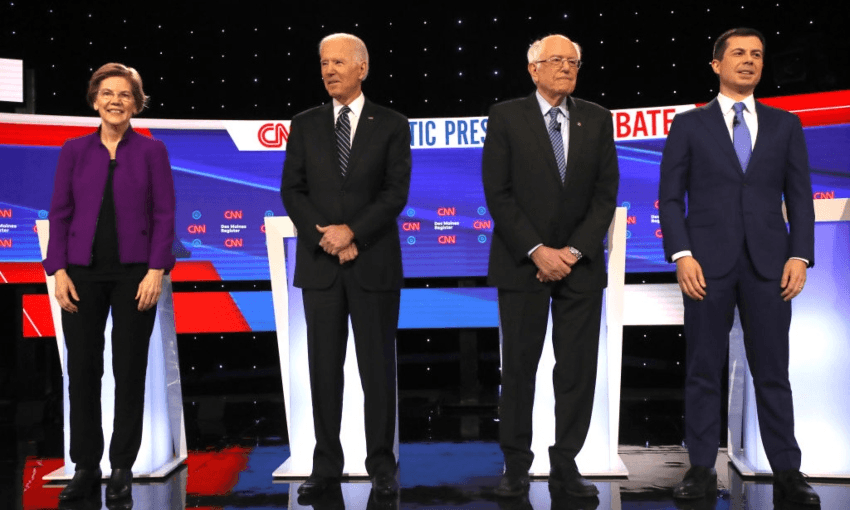With the impeachment process essentially shut down by the Senate, attention turns today to the state of Iowa, where it’s finally time for voting in the race to challenge Donald Trump for the presidency. So what are the Iowa Caucuses, why do they get such attention, and which Democrats are best placed to make it through? Korey Te Hira explains.
Imagine if, after Jacinda Ardern announced the date of the election, she and Simon Bridges had thought the best thing they could do to maximise their chances of winning was spend the next six months campaigning intensely in Invercargill.
With the Iowa caucuses being the traditional first primary contest of the US presidential election this is basically how America begins deciding who should be the most powerful person in the world. I want to help explain what makes the Iowa caucuses so important in the race for the White House.
Iowa and the other three early voting states have the power to winnow down the massive field of candidates trying to take on Trump to a small group who have a serious shot at the Democratic nomination. Iowa’s power comes from the fact that by going first it provides the media, public, and political pundits with the earliest evidence as to which candidates seem to have a legitimate shot at putting together a winning coalition of voters – and who seems likely to disappoint. From this, crucial campaign narratives are formed in the media that then both influence (we touch on how later), and are compounded by, the outcomes of the New Hampshire, Nevada, and South Carolina contests which quickly follow in that order.
It’s a close four-way race in Iowa with former Vice President Joe Biden, Senator Elizabeth Warren, Senator Bernie Sanders, and former Mayor Pete Buttigieg all in with a shot of winning. The candidates are typically defined according to whether they’re, say, “moderate” or “progressive” ideologically. This way of assessing candidates is popular among political junkies and media types as it is easy to understand and familiar. But although it does an OK job explaining voters’ candidate preferences, it also obscures a lot of important information.
Consider this: self-described democratic socialist Sanders and moderate Biden actually have cross-over support among working-class voters. Similarly, “big structural change” Warren shares the support of upper-middle class educated voters with Buttigieg who has comparatively tamer policy proposals. You would completely miss these dynamics looking at the race through a purely ideological lens, really mucking up your understanding of what is going on in a crowded caucus like Iowa.
Because of the byzantine rules of the caucuses, peoples’ second choices matter a lot. To keep it simple, for a candidate to be considered “viable” they must get at least 15% support in a precinct on the first round of caucusing (Iowa is divided into about 1,700 precincts). If they don’t reach 15%, then in that precinct their supporters are given the chance to change their preference to a remaining viable candidate in a second round of caucusing. A final statewide count of support across all precincts is then performed. Confusing, I know.
Given how close the race is campaigns must know who their potential supporters actually are (and not who the pundits tell them they are), how these peoples’ support will likely flow between candidates during the second round of caucusing, and therefore who to try and persuade to come on board. Getting this right could be the difference between winning and losing.
To become the Democratic presidential nominee a candidate must win a majority of nationwide “delegates” which are awarded based on candidates’ performances in various state contests, like Iowa. Importantly, the vast majority of delegates are awarded after the four early states have voted – Iowa only awards 41 out of the 1000s on offer across the US, for instance. So, if the number of delegates on offer is negligible what does Iowa actually provide that is so influential? Momentum.
Getting momentum is the goal of all campaigns – just as important as actually winning Iowa. The momentum gained by a candidate is dependent upon how much their actual performance exceeds the expectations of their performance set specifically for them by the media’s conventional wisdom. Beating expectations creates a “gaining ground” narrative in the news and on social media which essentially equals millions of dollars of free advertising for a campaign. This positive coverage in turn generates stuff that actually wins elections: donations, volunteers, endorsements, surrogates, and votes. It also crucially gets candidates a “ticket out of Iowa” – that is, being viewed as a credible challenger in New Hampshire and the next couple of state contests, at least.
Basing everything on expectations can lead to some counterintuitive results. For example, Senator Warren is expected to do pretty well in Iowa and almost certainly much better than another hopeful, Senator Amy Klobuchar. But, if Warren does as well as expected but only just places ahead of Klobuchar, then Klobuchar is more likely to get momentum heading into New Hampshire – she would have beaten her expectations by more than Warren. Such are the quirks of “tickets” from Iowa.
The Iowa caucuses are nearly here, and the trajectory of the Democratic primary race will soon be set. It may seem weird that such a small state has so much influence but that is how the American system works. So, when the Iowa results come out, look to see who has beaten expectations and seized the momentum. They will go into New Hampshire with a head of steam and may well be the next President of the United States.
Korey Te Hira graduated from the Harvard Kennedy School of Government in 2019 with a Master in Public Policy. He writes a weekly newsletter on US politics

